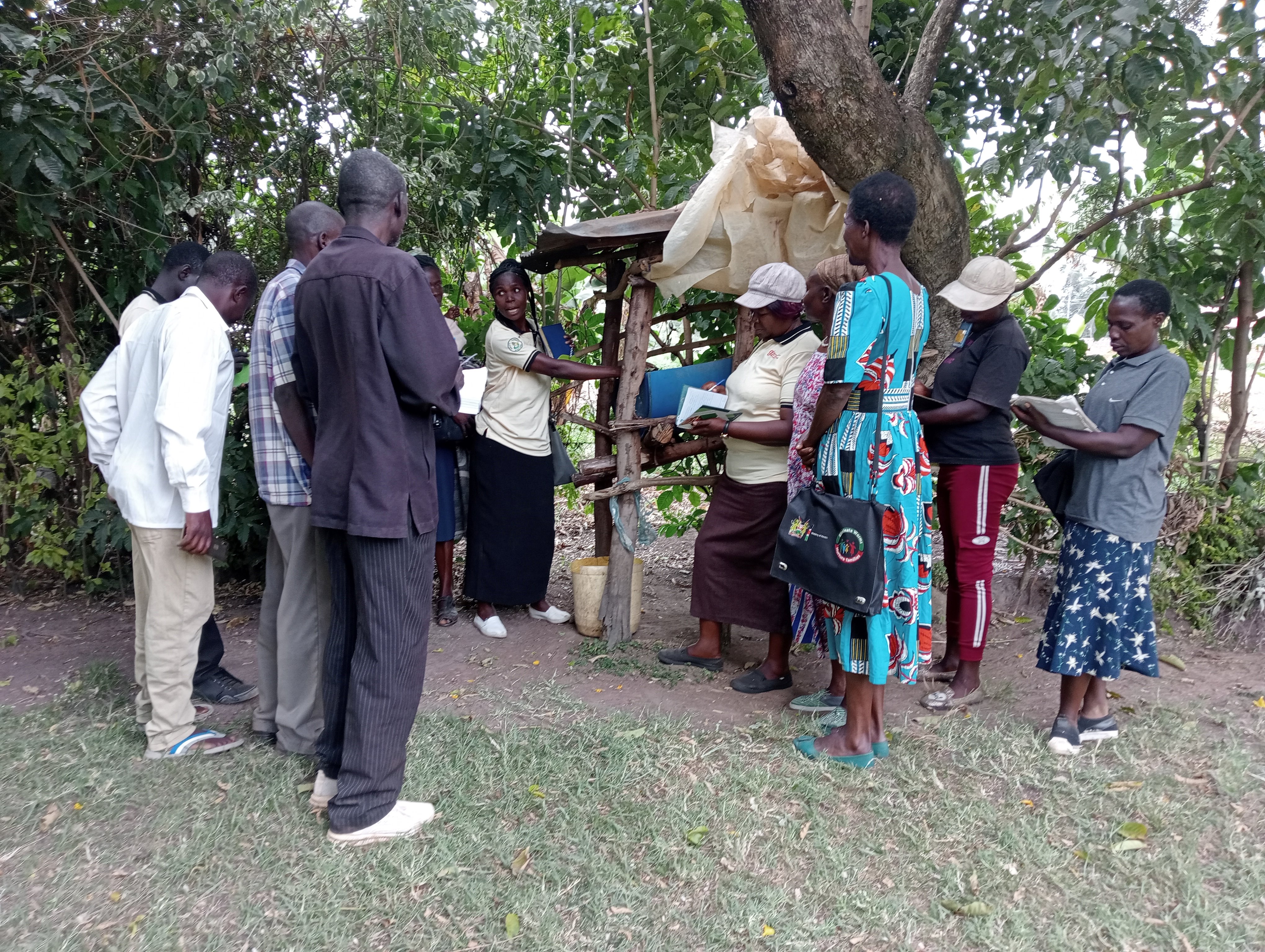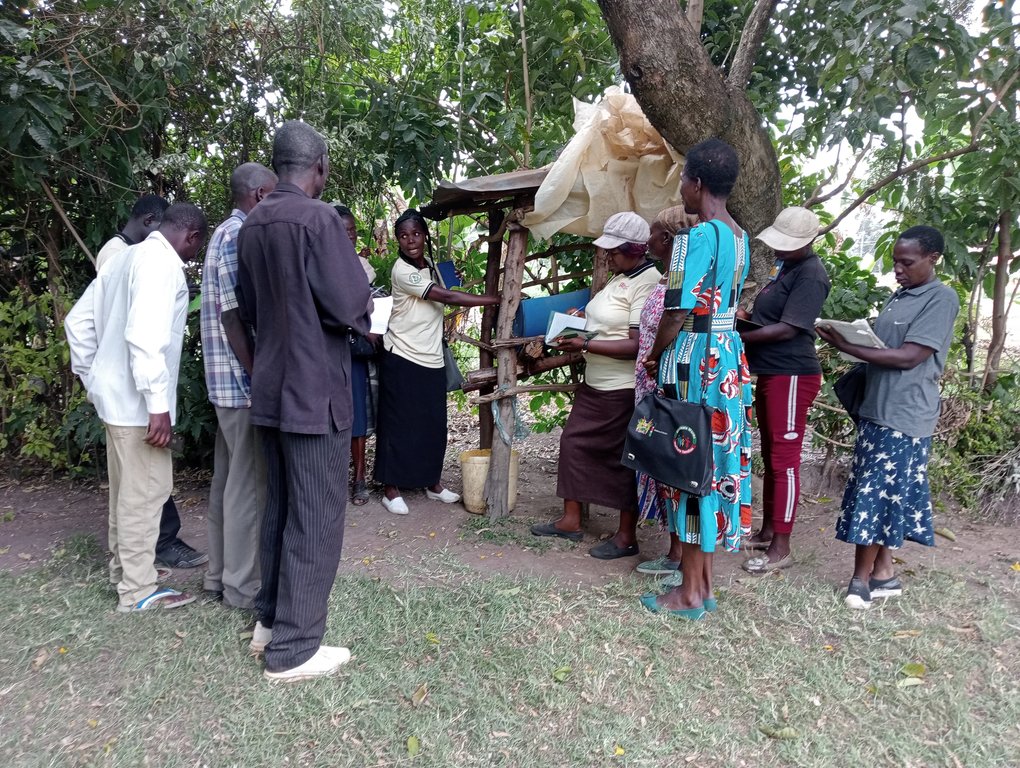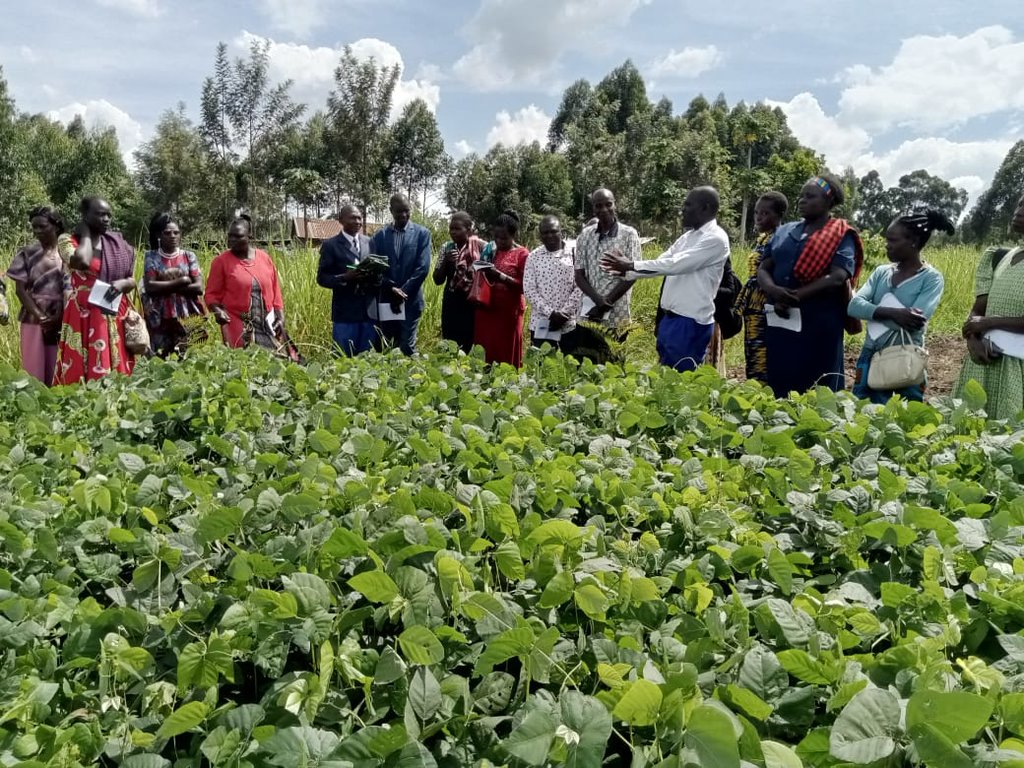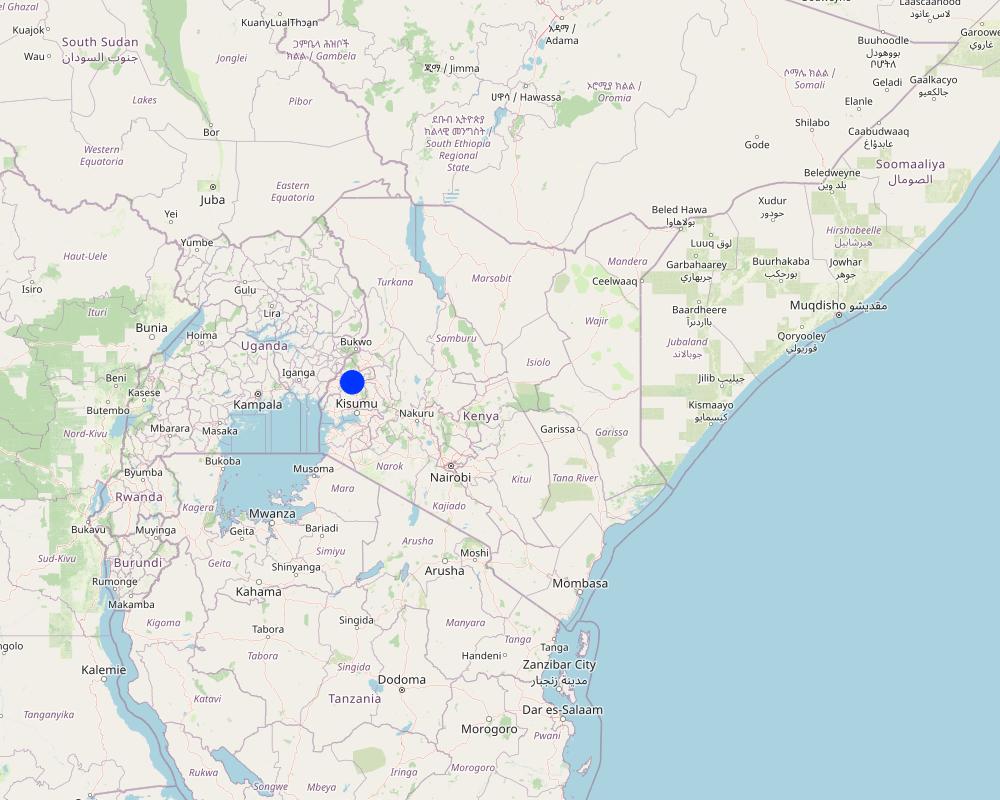Community Resource Persons (CRP) in agricultural extension [เคนยา]
- ผู้สร้างสรรค์:
- การอัพเดท:
- ผู้รวบรวม: William Akwanyi
- ผู้เรียบเรียง: Maureen Elegwa, Innocent Faith, Noel Templer, Tabitha Nekesa, Ahmadou Gaye, Siagbé Golli
- ผู้ตรวจสอบ: William Critchley, Rima Mekdaschi Studer, Sally Bunning
Mtu wa rasilimali za jamii/ Mkufunzi wa wakufunzi
approaches_6688 - เคนยา
ดูส่วนย่อย
ขยายทั้งหมด ย่อทั้งหมด1. ข้อมูลทั่วไป
1.2 รายละเอียดที่ติดต่อได้ของผู้รวบรวมและองค์กรที่เกี่ยวข้องในการประเมินและการจัดเตรียมทำเอกสารของแนวทาง
วิทยากรหลัก
ผู้เชี่ยวชาญ SLM:
Nyanja Churchill
+254 710 849370
churchillwn2@gmail.com
Kimaeti Farmers Community-Based Organization (CBO)
Bukembe East Ward, Kanduyi Sub-county, Bungoma County
เคนยา
ผู้เชี่ยวชาญ SLM:
ผู้เชี่ยวชาญ SLM:
ชื่อของโครงการซึ่งอำนวยความสะดวกในการทำเอกสารหรือการประเมินแนวทาง (ถ้าเกี่ยวข้อง)
Soil protection and rehabilitation for food security (ProSo(i)l)ชื่อของโครงการซึ่งอำนวยความสะดวกในการทำเอกสารหรือการประเมินแนวทาง (ถ้าเกี่ยวข้อง)
Deutsche Gesellschaft für Internationale Zusammenarbeit (GIZ)ชื่อของโครงการซึ่งอำนวยความสะดวกในการทำเอกสารหรือการประเมินแนวทาง (ถ้าเกี่ยวข้อง)
CIAT International Center for Tropical Agriculture (CIAT International Center for Tropical Agriculture) - เคนยา1.3 เงื่อนไขที่เกี่ยวข้องกับการใช้ข้อมูลที่ได้บันทึกไว้ผ่านทาง WOCAT
วันที่เก็บรวบรวมข้อมูล (ภาคสนาม):
03/02/2023
ผู้รวบรวมและวิทยากรหลักยอมรับเงื่อนไขเกี่ยวกับการใช้ข้อมูลที่ถูกบันทึกผ่านทาง WOCAT:
ใช่
1.4 การอ้างอิงถึงแบบสอบถามเรื่องเทคโนโลยี SLM
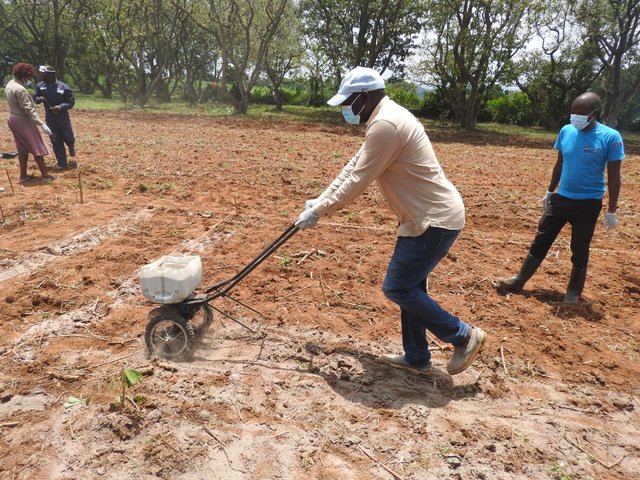
Lime application to acid soils [เคนยา]
Lime application is a rapid way to treat soil acidity and improve productivity.
- ผู้รวบรวม: William Akwanyi
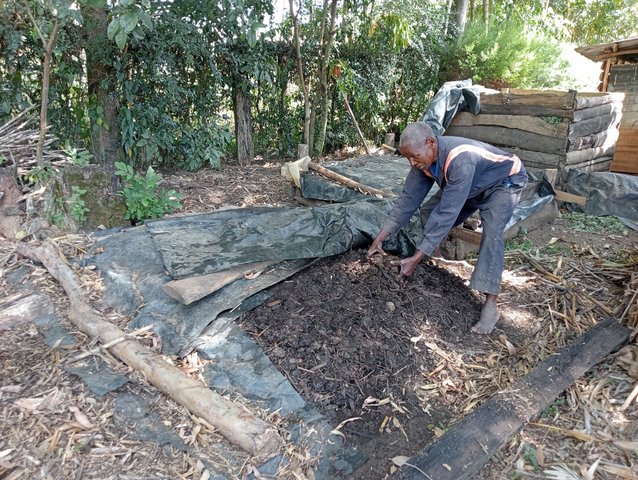
Compost for organic waste management and improved crop … [เคนยา]
Composting with on-farm organic solid waste management improves the soil sustainably and raises crop yields.
- ผู้รวบรวม: William Akwanyi
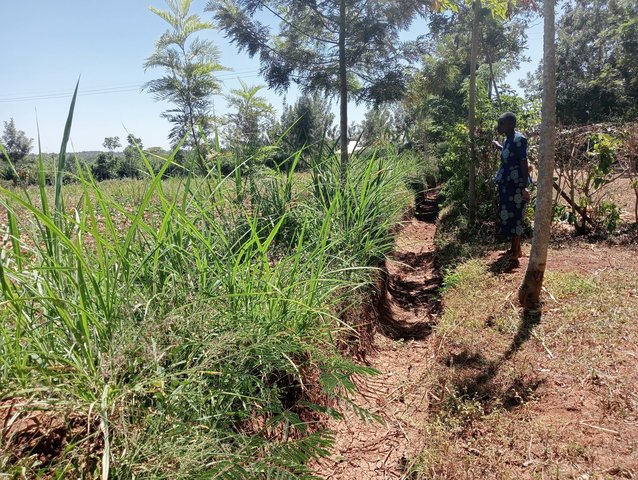
Retention ditches for soil and water conservation [เคนยา]
Retention ditches are channels aligned along the contour which are designed for surface runoff management. They improve water infiltration into the ground and prevent soil erosion.
- ผู้รวบรวม: William Akwanyi
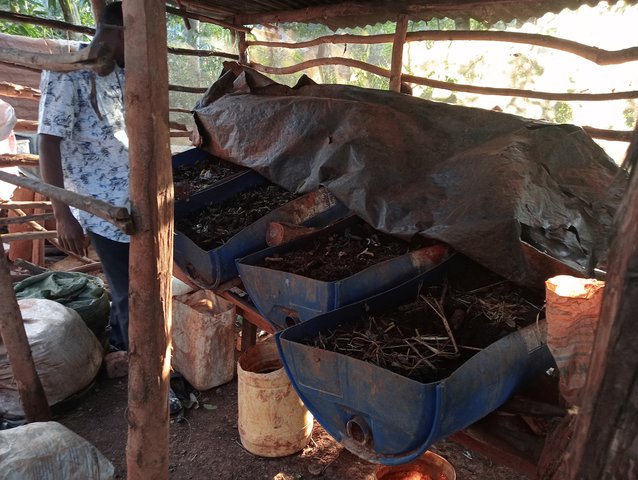
Vermicomposting: an effective liquid fertilizer and biopesticide [เคนยา]
Vermicomposting is an on-farm waste management strategy where worms are used for biodecomposition of wastes to produce a natural liquid fertilizer and pesticide.
- ผู้รวบรวม: William Akwanyi
2. คำอธิบายของแนวทาง SLM
2.1 การอธิบายแบบสั้น ๆ ของแนวทาง
Community Resource Persons (CRP) form a farmer-to-farmer learning approach that bridges the gap in agricultural extension, increases farmers' access to agricultural information (SLM knowledge), and increases the adoption of SLM practices.
2.2 การอธิบายอย่างละเอียดของแนวทาง
การอธิบายอย่างละเอียดของแนวทาง:
Community Resource Persons (CRPs) are farmers at the community-level who promote the adoption of SLM technologies by offering agricultural extension services. GIZ implements the ProSoil project in the Western Kenya counties of Kakamega, Siaya, and Bungoma through partners i.e., Welthungerhilfe (WHH) and Gesellschaft für Agrarprojekte in Übersee (GFA Consulting Group/ GFA). Further, these partners collaborate with other local non-governmental organizations (NGOs) and community-based organizations (CBOs) in the implementation of the project. Farmer groups belonging to local communities characterized by men, women, and youth are recruited by field officers from the implementing partners and trained in Sustainable Land Management (SLM) practices. The training is done by technical staff from the County Department of Agriculture. The implementing partners facilitate the trainings. The trained farmers (CRPs) are issued with certificates of recognition signed by GIZ ProSoil project manager, the head of the implementing partner, and the County Director of Agriculture at the County Department of Agriculture. These CBOs and farmer groups work closely with agricultural extension officers from the county departments of agriculture to disseminate different agricultural technologies and SLM measures. The aim of CRPs is to bridge the gap in agricultural extension by overcoming the problem of low extension staff-to-farmer ratios. The objective is to sustain the adoption of various SLM measures promoted by the project among the beneficiaries and non-project farmers.
In Bukembe East Ward, Bungoma County, GFA collaborates with Kimaeti Farmers CBO to implement the Soil Protection and Rehabilitation of Degraded Soil for Food Security (ProSoil) project. Kimaeti Farmers CBO recruited agriculture field technicians who were then trained in SLM practices by GFA. The trained field technicians sensitize local communities in various operational areas about the project and recruit farmer groups: 25 farmers per group. Each field technician manages several groups per sub location and takes them through trainings and demonstrations on soil protection and rehabilitation technologies. Farmer groups are also trained on group organization development and management to enhance group cohesion. Each farmers group selects 3 CRPs who undergo specialized training to equip them with more skills and expertise to follow up, mentor and coach fellow farmers. These CRPs also monitor implementation of various technologies, gather farmer feedback, and even reach out to other farmers in the community not reached by the project. This extension service is usually done voluntarily. However, some farmers reward the CRPs for the advisory services in cash or kind. In some cases, CRPs who are specialised in some SLM technologies e.g., construction of structures for vermicomposting become co-trainers and may enter into contractual agreements with GIZ, GFA, or any other institution that wants their services. In this case, they are paid as agreed on the contracts.
Each CRP manages a cluster of 5–7 farmers. They also reach out to farmers within their respective communities according to consultatively agreed calendars/timeframes. Every available opportunity is used by CRPs to spread SLM knowledge, including meeting farmers at their farms; convening farmers at common locations within their communities where they talk to them about SLM; farmer field days organised by the implementing partners, or the county department of agriculture, etc. Hence, CRPs attract the attention of many farmers, including those who are direct beneficiaries of the ProSoil project and those who are not direct beneficiaries. CRPs are thus important in improving farmers' access to agricultural information at little or no cost since CRPs work on a voluntary basis.
The CRP approach has been successful in bringing together female and male, and youthful, middle-aged, and elderly farmers of different socio-cultural and economic backgrounds on issues of common interest i.e., SLM, household food security, and economic empowerment. This has enhanced communication, built social solidarity, and enhanced social cohesion among the farmers.
2.3 รูปภาพของแนวทาง
2.5 ประเทศ ภูมิภาค หรือสถานที่ตั้งที่ได้นำแนวทางไปใช้
ประเทศ:
เคนยา
ภูมิภาค/รัฐ/จังหวัด: :
Bungoma County in Western Kenya
ข้อมูลเฉพาะเพิ่มเติมของสถานที่ตั้ง:
Bukembe East Ward, Kanduyi Sub-county, Bungoma County
Map
×2.6 วันที่เริ่มต้นและสิ้นสุดของแนวทาง
ระบุปีที่เริ่ม:
2021
ความคิดเห็น:
Farmers are still learning from each other through the CRP approach.
2.7 ประเภทของแนวทาง
- ใช้โครงงานหรือแผนงานเป็นฐาน
2.8 เป้าหมายหรือวัตถุประสงค์หลักของแนวทาง
Aim: To bridge the gap in agricultural extension.
Objectives:
1. To improve farmers' access to agricultural information.
2. To sustain the adoption of new technologies trained to the project beneficiaries and non-project farmers.
3. To overcome the problem of low extension staff-to-farmer ratio through farmer-to-farmer learning.
2.9 เงื่อนไขที่เอื้ออำนวยหรือเป็นอุปสรรคต่อการนำเทคโนโลยีภายใต้แนวทางนี้ไปปฏิบัติใช้
บรรทัดฐานและค่านิยมทางสังคม วัฒนธรรม ศาสนา
- เอื้ออำนวย
1. General acceptance by the community.
2. Ability to bring together of different socio-cultural and economic backgrounds on issues of common interest i.e., SLM, household food security, and economic empowerment which has enhanced communication, built social solidarity, and enhanced social cohesion among community members.
การมีไว้ให้หรือการเข้าถึงแหล่งการเงินและบริการ
- เป็นอุปสรรค
CRPs work on voluntary basis; hence, may not be motivated to reach out to farmers in areas that are very far from their reach.
การจัดตั้งระดับองค์กร
- เอื้ออำนวย
Availability and willingness of Kimaeti CBO to collaborate with GFA.
การร่วมมือหรือการทำงานประสานกันของผู้ลงมือปฏิบัติ
- เอื้ออำนวย
Linkages and partnerships among different organizations and institutions, including GIZ, GFA, Kimaeti CBO, etc. which expanded the outreach of the approach.
กรอบแนวทางในการดำเนินการด้านกฎหมาย (การถือครองที่ดิน สิทธิในการใช้ที่ดินและน้ำ)
- เอื้ออำนวย
Access to farming land where farmers implement SLM technologies.
การกำกับดูแลที่ดิน (การตัดสินใจ การนำเอาไปปฏิบัติใช้ และการบังคับใช้)
- เป็นอุปสรรค
Women and youth farmers are limited in their access, use, and control of land. Hence, they may not be able to implement certain SLM technologies even if they gained knowledge about them through CRPs who are fellow farmers e.g., agroforestry.
ความรู้เกี่ยวกับ SLM การเข้าถึงการสนับสนุนด้านเทคนิค
- เอื้ออำนวย
SLM knowledge among technical staff in the collaborating institutions and documented references.
ปริมาณงานที่ทำได้ กำลังคนที่มีให้
- เอื้ออำนวย
CRPs from the communities who are willing to work with fellow farmers.
- เป็นอุปสรรค
Voluntary nature of the CRPs' support - CRPs are likely to sacrifice their own farmwork at the expense of the CRP work, something that may discourage them if they get poor harvest.
3. การมีส่วนร่วมและบทบาทของผู้มีส่วนได้ส่วนเสียที่เกี่ยวข้อง
3.1 ผู้มีส่วนได้ส่วนเสียที่เกี่ยวข้องในแนวทางนี้และบทบาท
- ผู้ใช้ที่ดินระดับท้องถิ่นหรือชุมชนระดับท้องถิ่น
Farmers - men, women, and youth.
Targeted by the technologies, they learn from other farmers, and implement the technologies.
- องค์กรที่ขึ้นอยู่กับชุมชน
Kimaeti Farmers Community-Based Organization
Has recruited a team of trained SLM specialists who pass the SLM knowledge to the community resource persons in the community.
- ผู้เชี่ยวชาญ SLM หรือที่ปรึกษาการเกษตร
SLM specialists from GIZ ProSoil project, GFA, and Kimaeti Farmers Community-Based Organization.
SLM specialists from GIZ ProSoil project - supported in the technical design of the approach.
SLM specialists from GFA - ProSoil implementing partner, trains the Community-Based Organizations that implement the approach.
SLM specialists from Kimaeti Farmers Community-Based Organization - pass the SLM knowledge to the community resource persons in the community.
- รัฐบาลระดับท้องถิ่น
Agricultural extension officers from the county government department of agriculture.
Work hand-in-hand with SLM specialists to pass the SLM knowledge to the farmers.
- องค์การระหว่างประเทศ
GIZ
Proposal design and financial support to the implementation of the approach.
ถ้ามีผู้มีส่วนได้ส่วนเสียหลายคนที่เกี่ยวข้องให้ระบุหน่วยงานตัวแทน:
GIZ
3.2 การเกี่ยวข้องของผู้ใช้ที่ดินระดับท้องถิ่นหรือชุมชนระดับท้องถิ่นในช่วงต่างๆของแนวทาง
| ความเกี่ยวข้องของผู้ใช้ที่ดินระดับท้องถิ่นหรือชุมชนระดับท้องถิ่น | ระบุผู้ที่มีส่วนเกี่ยวข้องและอธิบายกิจกรรม | |
|---|---|---|
| การริเริ่มหรือการจูงใจ | ไม่ลงมือ | Farmers in the community, targeted by the SLM technologies, they implement the technologies. |
| การวางแผน | ปฏิสัมพันธ์ | Community resource persons and other farmers in the community jointly agree on when to engage each other, especially time and venue for capacity building. |
| การดำเนินการ | ปฏิสัมพันธ์ | Based on the status of the farmers, including land size, available capital, status of land degradation, etc. community resource persons and other farmers decide which SLM technologies are best for each farm. |
| การติดตามตรวจสอบหรือการประเมินผล | ไม่ลงมือ | The planning for and conduct of monitoring and/ or evaluation is a role of GIZ and WHH. Farmers are mainly interviewed based on pre-determined questions. |
| Research | ไม่มี |
3.3 แผนผังแสดงขั้นตอนการทำงาน (ถ้ามี)
คำอธิบาย:
The ProSoil Project (GIZ and GFA) provides financial resources for the training of CRPs. The CRPs are trained by SLM specialists from the County Department of Agriculture. The CRPs provide advisory services to farmers.
ผู้เขียน:
William Akwanyi
3.4 การตัดสินใจเลือกใช้เทคโนโลยี SLM
ระบุผู้ที่ทำการตัดสินใจเลือกเทคโนโลยีมากกว่าหนึ่งวิธีไปปฏิบัติใช้:
- ผู้ใช้ที่ดินเป็นผู้ตัดสินใจหลัก โดยการสนับสนุนจากผู้เชี่ยวชาญ SLM
การอธิบาย:
Decisions on what SLM technologies to implement were made mainly by farmers supported by SLM specialists from GIZ ProSoil project, GFA, and Kimaeti Farmers Community-Based Organization.
ระบุว่าการตัดสินใจตั้งอยู่บนพื้นฐานของ:
- การประเมินความรู้ SLM ที่ได้ทำการบันทึกไว้เป็นอย่างดี (การใช้ข้อมูลในการตัดสินใจ)
- ประสบการณ์และความคิดเห็นส่วนตัว (ไม่ได้ลงบันทึกไว้)
4. การสนับสนุนด้านเทคนิค การสร้างขีดความสามารถ และการจัดการด้านความรู้
4.1 การสร้างขีดความสามารถ / การอบรม
ได้มีการจัดอบรมให้แก่ผู้ใช้ที่ดินหรือผู้มีส่วนได้ส่วนเสียคนอื่น ๆ หรือไม่:
ใช่
ให้ระบุว่าใครเป็นผู้ได้รับการอบรม:
- ผู้ใช้ที่ดิน
- เจ้าหน้าที่ภาคสนาม / ที่ปรึกษา
ถ้าเกี่ยวข้อง ให้ระบุ เพศ อายุ สถานภาพ ชาติพันธุ์ เป็นต้น:
CRPs from each village of about 25 farmers
รูปแบบการอบรม:
- กำลังดำเนินการ
- เกษตรกรกับเกษตรกร
- ใช้พื้นที่ทำการสาธิต
หัวข้อที่พูด:
1. Conservation Agriculture
2. Agroforestry
3. Soil and Water Conservation measures
4. Integrated Soil Fertility and Pest Management (ISF&PM)
5. Push-pull
6. Good Agronomic Practices
ความคิดเห็น:
GFA trained/ trains Kimaeti Farmers CBO field technicians in SLM. The trained technicians then train the CRPs.
4.2 การบริการให้คำแนะนำ
ผู้ใช้ที่ดินมีการเข้าถึงการรับบริการให้คำปรึกษาหรือไม่:
ใช่
ระบุว่ามีบริการให้คำปรึกษาหรือไม่:
- ไปเยี่ยมชมสถานที่
- ที่ศูนย์ถาวร
การอธิบาย/แสดงความคิดเห็น:
CRPs advise farmers at their farms whenever they visit them. Meetings are held on needs basis between farmers and the CRPs where pieces of advice are given to farmers.
4.3 การเสริมความแข็งแกร่งให้กับสถาบัน (การพัฒนาองค์กร)
สถาบันได้รับการจัดตั้งขึ้นมาหรือเสริมความแข็งแกร่งโดยแนวทางนี้หรือไม่:
- ใช่ อย่างมาก
ระบุระดับของสถาบันที่ได้รับการเสริมความแข็งแกร่งหรือจัดตั้งขึ้นมา:
- ท้องถิ่น
อธิบายถึงสถาบัน บทบาทและความรับผิดชอบ สมาชิก เป็นต้น:
Kimaeti Farmers CBOs and farmer groups at community level whose member farmers are capacity build and are able to learn from each other.
ระบุประเภทของการให้ความช่วยเหลือสนับสนุน:
- การสร้างขีดความสามารถ / การอบรม
ให้รายละเอียดเพิ่มเติม :
Kimaeti Farmers CBO technical officers have been trained in SLM practices.
4.4 การติดตามตรวจสอบและประเมินผล
การติดตามตรวจสอบและประเมินผลเป็นส่วนหนึ่งของแนวทางหรือไม่:
ใช่
ความคิดเห็น:
GIZ and GFA regularly follows up with farmers to check on the implementation of technologies promoted under this approach.
ถ้าตอบว่าใช่ แสดงว่าการจัดเตรียมเอกสารนี้มุ่งหวังที่จะเอาไปใช้สำหรับการติดตามตรวจสอบและประเมินผลใช่หรือไม่:
ไม่ใช่
ความคิดเห็น:
This documentation in intended for keeping a record of SLM technologies and approaches.
4.5 การวิจัย
การวิจัยเป็นส่วนหนึ่งของแนวทางหรือไม่:
ไม่ใช่
5. การสนับสนุนด้านการเงินและวัสดุอุปกรณ์
5.1 ระบุงบประมาณประจำปีสำหรับแนวทาง SLM นี้
ถ้าหากว่างบประมาณประจำปีไม่เป็นที่ทราบแน่นอน ให้ระบุช่วงลงไป:
- 10,000-100,000
แสดงความคิดเห็น (แหล่งของการระดมทุน ผู้บริจาคคนสำคัญ):
Training costs for training 25 CRPs met by GIZ through GFA.
5.2 การสนับสนุนด้านการเงิน / วัสดุอุปกรณ์ให้แก่ผู้ใช้ที่ดิน
ผู้ใช้ที่ดินได้รับการสนับสนุนด้านการเงิน / วัสดุอุปกรณ์ไปปฏิบัติใช้เทคโนโลยีหรือไม่:
ไม่ใช่
5.3 เงินสนับสนุนสำหรับปัจจัยนำเข้า (รวมถึงแรงงาน)
- ไม่มี
ความคิดเห็น:
No labour was provided by land users.
5.4 เครดิต
มีการจัดหาเครดิตมาให้ภายใต้แนวทาง SLM หรือไม่:
ไม่ใช่
5.5 แรงจูงใจหรือเครื่องมืออื่น ๆ
แรงจูงใจหรือเครื่องมืออื่น ๆ ได้ถูกนำไปใช้ส่งเสริมการใช้เทคโนโลยี SLM หรือไม่:
ใช่
ถ้าใช่ ระบุ:
Value addition to promote marketability of farm produce e.g., mucuna. This encouraged farmers to grow mucuna as a green manure cover crop.
6. การวิเคราะห์ผลกระทบและการสรุป
6.1 ผลกระทบของแนวทาง
ช่วยในการตัดสินใจโดยดูจากหลักฐาน ได้หรือไม่:
- ไม่ใช่
- ใช่ เล็กน้อย
- ใช่ ปานกลาง
- ใช่ อย่างมาก
Farmers were motivated to implement the SLM technologies that they were trained on by the CRPs, especially having seen how the CRPs had benefited from the SLM practices.
ช่วยให้ผู้ใช้ที่ดินนำเอาเทคโนโลยี SLMไปใช้และบำรุงรักษาสภาพไว้ได้หรือไม่:
- ไม่ใช่
- ใช่ เล็กน้อย
- ใช่ ปานกลาง
- ใช่ อย่างมาก
The CRPs reached out to the land users/ farmers and taught them how to implement the SLM technologies.
ปรับปรุงความร่วมมือกันและการดำเนิน งานของ SLM ได้อย่างมีประสิทธิผลหรือไม่:
- ไม่ใช่
- ใช่ เล็กน้อย
- ใช่ ปานกลาง
- ใช่ อย่างมาก
Farmers are not paying for the extension services that they receive from the CRPs.
ระดมกำลังหรือปรับปรุงการเข้าถึงแหล่ง เงินทุนสำหรับการดำเนินการ SLM หรือไม่:
- ไม่ใช่
- ใช่ เล็กน้อย
- ใช่ ปานกลาง
- ใช่ อย่างมาก
ปรับปรุงความรู้และความสามารถของผู้ใช้ที่ดินในการดำเนินการ SLM หรือไม่:
- ไม่ใช่
- ใช่ เล็กน้อย
- ใช่ ปานกลาง
- ใช่ อย่างมาก
SLM knowledge received from the CRPs.
ทำให้ผู้ใช้ที่ดินระดับท้องถิ่นมีอำนาจขึ้น ปรับปรุงการเข้าร่วมของผู้มีส่วนได้ส่วนเสียให้ดีขึ้นหรือไม่:
- ไม่ใช่
- ใช่ เล็กน้อย
- ใช่ ปานกลาง
- ใช่ อย่างมาก
Collaboration of GFA and GIZ, GFA and Kimaeti Farmers CBO strengthened.
ทำให้กลุ่มด้อยโอกาสมีอำนาจทางสังคมและเศรษฐกิจหรือไม่:
- ไม่ใช่
- ใช่ เล็กน้อย
- ใช่ ปานกลาง
- ใช่ อย่างมาก
Farmers with limited resources to invest in capacity building/ training received free SLM knowledge.
6.2 แรงจูงใจหลักของผู้ใช้ที่ดินเพื่อที่จะนำ SLM ไปปฏิบัติใช้
- การผลิตที่เพิ่มขึ้น
Farmers harvested more after implementing the SLM technologies than when they were not implementing the technologies.
- การเสื่อมของที่ดินลดลง
Most promoted SLM practices reduced degradation of farmlands e.g., soil and water conservation measures.
- เกียรติภูมิ แรงกดดันทางสังคม ความเชื่อมแน่นทางสังคม
Farmers of diverse social and economic statuses could meet for a common goal of learning about SLM.
- ความรู้และทักษะ SLM ที่เพิ่มพูนขึ้น
Farmers received training about SLM from the CRPs.
- การบรรเทาด้านความขัดแย้ง
CRPs are able to solve conflicts that arise within the groups
6.3 ความยั่งยืนของกิจกรรมของแนวทาง
ผู้ใช้ที่ดินสามารถทำให้สิ่งต่างๆ ที่ได้ปฏิบัติใช้โดยแนวทางนี้ยั่งยืนได้หรือไม่ (โดยไม่มีการสนับสนุนจากภายนอก):
- ใช่
ถ้าตอบว่าใช่ ให้อธิบายว่าอย่างไร :
Most of the SLM practices promoted under the approach have greatly improved the farms. Hence, a motivation to continue implementing even without donor support.
6.4 จุดแข็งและข้อได้เปรียบของแนวทาง
| จุดแข็ง / ข้อได้เปรียบของแนวทางในทัศนคติของผู้ใช้ที่ดิน |
|---|
| Easy access to CRPs since they are members of the same communities with the target farmers. |
| Evidence-based learning from fellow farmers is a motivation for farmers to invest in SLM. |
| It could be a source of income for the CRPs; some earn an income by providing extension services to other farmers |
| จุดแข็ง / ข้อได้เปรียบของแนวทางในทัศนคติของผู้รวบรวมหรือวิทยากรหลัก |
|---|
| A cost-effective method of disseminating agricultural information. |
6.5 จุดอ่อน / ข้อเสียเปรียบของแนวทางและวิธีในการแก้ไข
| จุดอ่อน / ข้อเสียเปรียบในทัศนคติของผู้ใช้ที่ดิน | สามารถแก้ไขปัญหาได้อย่างไร |
|---|---|
| CRPs may lack resources to reach out to farmers since they work on voluntary basis. | Formal recognition of CRPs by the government of Kenya. Government setting aside some funds to support the CRPs |
| Resistance from some farmers. | CRPs to be provided with some form of identification, |
7. การอ้างอิงและการเชื่อมต่อ
7.1 วิธีการหรือแหล่งข้อมูล
- ไปเยี่ยมชมภาคสนาม การสำรวจพื้นที่ภาคสนาม
One field visit involving demonstration of how CRPs interact with farmers.
- การสัมภาษณ์กับผู้ใช้ที่ดิน
Discussion with a CRP group
- การสัมภาษณ์ผู้เชี่ยวชาญด้าน SLM หรือผู้ชำนาญ
Interview with GFA and Kimaeti CBO SLM specialist and several follow-up calls.
7.3 เชื่อมโยงกับข้อมูลที่มีอยู่บนออนไลน์
ชื่อเรื่องหรือคำอธิบาย:
Training Community Resource Persons and Panchayat members in Tamil Nadu
URL:
https://indo-germanbiodiversity.com/project-details-265.html
ลิงก์และโมดูล
ขยายทั้งหมด ย่อทั้งหมดลิงก์

Lime application to acid soils [เคนยา]
Lime application is a rapid way to treat soil acidity and improve productivity.
- ผู้รวบรวม: William Akwanyi

Compost for organic waste management and improved crop … [เคนยา]
Composting with on-farm organic solid waste management improves the soil sustainably and raises crop yields.
- ผู้รวบรวม: William Akwanyi

Retention ditches for soil and water conservation [เคนยา]
Retention ditches are channels aligned along the contour which are designed for surface runoff management. They improve water infiltration into the ground and prevent soil erosion.
- ผู้รวบรวม: William Akwanyi

Vermicomposting: an effective liquid fertilizer and biopesticide [เคนยา]
Vermicomposting is an on-farm waste management strategy where worms are used for biodecomposition of wastes to produce a natural liquid fertilizer and pesticide.
- ผู้รวบรวม: William Akwanyi
โมดูล
ไม่มีโมดูล


